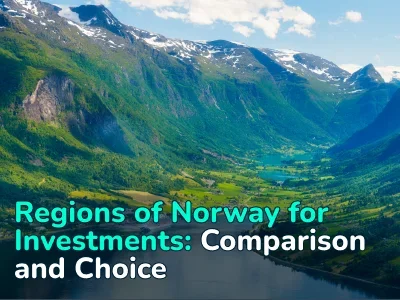
«Going into investments is not enough — you have to realize how you can get out of them.» What is crowdinvesting, and how is it changing the real estate market?
Do you want to invest in expensive real estate, but do not have enough money for a purchase? Consider crowdinvesting — it is a profitable way to start investing with small sums in both residential and commercial properties. Read on for all the details of this process.
Is real estate unattainable? This concept has long been a myth. Yes, traditional investments require large investments, but today we are not talking about them, but about crowdinvesting, that is, collective investments in real estate. What types of real estate can be invested in using crowdinvesting? How is this area generally regulated? What do I look for when choosing a crowdinvesting platform and an object for investment? Who is involved in this whole process? How will this method of investing develop further? About all of this — in our expert material.
To avoid confusion over the terms, let’s first understand how crowdinvesting differs from classic crowdfunding. Usually, crowdfunding is defined as the financing of some social or creative projects (for example, raising money for a concert or repairing an exhibition hall). In such investments, however, material rewards are not a priority — the «idea» itself plays a major role. When people are interested in receiving income from collective investments in projects (including real estate), it is more correct to talk about crowdinvesting.
A little context. Crowdinvesting in real estate through REIT funds originated in the U.S. back in the 1960s, when President Eisenhower signed the relevant bill. But the main popularity of this instrument came much later. Accordingly, the U.S. is the country where this investment format is most widely used. However, the collective investment mechanism is actively «putting down roots» in different countries — at present in Europe and developed Asian countries there are more than 150 companies offering these services. If we talk about the numbers and forecasts, according to a report by Polaris Market Research, the share of the world market of real estate crowdinvesting by 2030 will grow to $250.62 billion. The forecast is pretty impressive, given that in 2021 the volume of this market was $10.78 billion.

Who is involved in the crowdinvesting process?
There are usually three parties involved in collective financing: the sponsor, the platform, and the investor. The sponsor (in the form of a management company or businessman) oversees the investment, purchases the property, manages it, and, if necessary, sells it. The investor, on the other hand, contributes funds and ultimately receives income based on the share contributed. A crowdfunding platform is an intermediary platform between the sponsor and the investor.
What to consider when choosing a crowdinvesting platform?
Crowdinvesting platforms evaluate projects and sponsors, and check investors for the necessary requirements. Each platform requires a KYC (know your customer) procedure before investing.
Most crowdinvesting platforms focus on commercial real estate or apartment buildings. But you can also find platforms for making money on houses for rent. Investing in rental homes can generate income for investors in two ways: 1) growth in property values, 2) rental income.
Here are the most important criteria to consider when choosing a real estate crowdinvesting platform:
- Investor status. Some platforms require the investor to be accredited. This means that the «net» value of his household must be at least $1 million (not counting the primary residence), or another option — the investor’s annual income must not be below $200,000.
- Minimum investment. The entry threshold for platforms varies: somewhere you can start with $10, and somewhere with $100,000.
- Approach to investments. Each service has its own philosophy and investment strategy. Some offer funds, such as a real estate investment trust (REIT), while others provide direct investment opportunities. They may also emphasize different types of real estate, as well as focus on debts or equities. All of these things affect your long-term prospects.
- The waiting period for profit. In the case of collective investment in real estate (as opposed to the stock market) it can take years before you get any results, so this nuance must also be taken into account.
- Risks. All investments carry a certain level of risk, so it is advisable to spend time evaluating the platform, its offerings and your options.
Top of the world's most popular crowdinvesting platforms:
In America: CityVest, Gatsby, CrowdStreet, EquityMultiple, Arrived Homes, Fundrise, Roofstock, Streitwise, Ark7.
In Europe: Reinvest24, Max Crowdfund, Brickstarter, EvoEstate.
In Russia: PNK rental, Aktivo.
Next, we give the word to experts who will share their observations and experiences related to crowdinvesting in real estate.
«You can invest from your computer, you don't have to touch a brick yourself»
Marc Bakker, the marketing Manager of Max Crowdfund, told us about the advantages and disadvantages of real estate crowdinvesting:

Advantages:
- Investing with little money in real estate projects in different countries.
- You can diversify your portfolio by investing in several projects at once.
- Investing from your computer, you don’t have to touch a brick yourself.
- No problems with documentation, tenants or whatsoever.
- The real estate opportunities are selected by the real estate crowdinvesting platform, so you don’t have to look for any real estate opportunities yourself.
- You can choose between long term investments or short term.
Disadvantages:
- The returns are most of the time with a maximum of 12% a year.
- Once invested, you have to wait out the investment period before you can cash out.
- There is less control in decision-making. The investor cannot influence the process, the entire strategy is determined and controlled, as a rule, by the sponsor in the form of a management company.
«Be sure to study the laws of the country in whose real estate you are going to invest»
Mikhail Kostromin, CCO (chief commercial officer) AKTIVO LLC, explained what types of real estate funds there are and which instrument of such investment is most popular in Russia.
 — As a rule, there are four types of real estate funds:
— As a rule, there are four types of real estate funds:
1. Rental funds — they are created to manage real estate and rent it out. Both residential and commercial objects can be brought into such funds.
2. Constructional — are focused on the construction of facilities that can later be sold or leased.
3. Developing — are intended for the development of land or ready-made real estate and imply development, redevelopment, repair, etc.
4. Land — specialize in the purchase and re-registration of land plots, conversion to another category of land use, land surveying and other procedures that increase the value of these plots.
Most real estate funds belong to the rental type. They are divided by real estate format: residential real estate funds (including apartments, houses or cottages), and commercial real estate funds (hotels, offices, warehouses, retail real estate, etc.).
To start investing, you need to decide on the format of the property (residential or commercial), then choose a fund and carefully examine the management company and the object of investment, and then make the purchase of shares.
Of course, you should definitely study the legislation, taxation and fund principles of the country (or even state or city) in whose real estate you are going to invest — almost every case will have its own nuances. In Russia the main regulators in the market of collective investments in real estate are the Central Bank and Federal Law 156 «On investment funds», in UAE — «UAE REIT Regulations», in USA this sphere is regulated by law 86-779 and some others.
Speaking of crowdinvesting in real estate in Russia, the most reliable instrument is ZPIFN (closed-end mutual funds of real estate). And this is explained by the fact that all activity of funds is governed by 156-FZ of the Russian Federation and is regulated by the Central Bank.
Real estate ZPIFs are classified into two types: exchange-traded — units of such a fund are in free circulation on the stock exchange and the entry threshold is usually several thousand rubles; non-exchange-traded — units of such a fund can be purchased through a fund manager or a management company (for unqualified investors since 2017 the minimum value of an investment unit is 300,000 rubles).
They are also divided by type of investor, based on the goals and objectives of the fund:
- For qualified investors: in addition to real estate, the fund may include any financial assets — stocks, bonds, futures, own and borrowed money. In order to obtain the status of a qualified investor, you must meet a number of criteria and pass the appropriate certification.
- For unqualified investors: the property will include a very limited list of assets — mainly real estate objects and financial instruments, which are traded on the market. To become the shareholder of the chosen fund, the unqualified investor needs: to register and form the personal account of the investor on the company’s website, to be verified, to make an application for purchase of units, to conclude the contract and to pay the bill. After confirmation of payment, the fund’s units will be transferred to him, and this will be recorded in the register of investors.
Pros of ZPIFN:
- Safety and convenience (the investor receives regular payments, as well as comprehensive reporting on the state of the portfolio, fund and object).
- Fully passive income (the investor receives a net income, cleared of all taxes, as the Management Company is a tax agent).
Cons of ZPIFN:
- Average liquidity (if we talk about non-exchange ZPIFN, the average period of sale of the unit is about 1-1.5 months).
- Floating yields throughout the year (month-to-month yields may vary for a variety of reasons).
The foreign analogue of ZPIFNs are REIT-funds. To invest with their help, you need to open an account with one of the brokers, as well as a currency account.

«There is now a paradigm shift in investing»
Dmitry Efremov, founder of the investment platform Invest Meeting Point, shared his thoughts on the prospects of crowdinvesting in real estate and on what to consider when choosing an object for such investment.
 — I advise choosing platforms that already have a certain history and realized cases. And when selecting an object for such investments, one should take into account the profitability, the reliability of the management company and the possibility of exiting the investment. These are the three most important criteria, because it is not enough to enter investments — you must immediately understand how you can exit if necessary.
— I advise choosing platforms that already have a certain history and realized cases. And when selecting an object for such investments, one should take into account the profitability, the reliability of the management company and the possibility of exiting the investment. These are the three most important criteria, because it is not enough to enter investments — you must immediately understand how you can exit if necessary.
As for risks, the biggest one is the loss of value of the object, because then your investment is reset. And then, of course, there are the risks of possible changes in the legal framework, which can also be introduced.
In general, I think that crowdinvesting in the real estate sphere is only gaining momentum and will continue to develop very actively. There is now a paradigm shift in investing: whereas previously everyone sought to invest in a specific physical object, thanks to crowdinvesting, people are switching from a physical object to a share in that object. And this is certainly a promising trend: large companies attract investments for the realization of their project, while the average investor expands his investment portfolio and quietly increases capital without taking out loans.
Author
I am responsible for editorial work. I write expert interviews and guides.



















